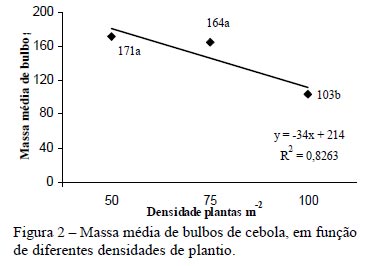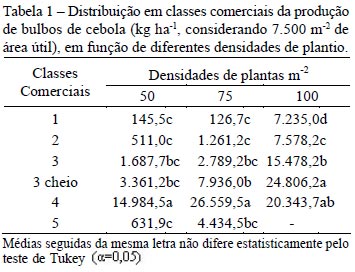The adequate distribution of onions (Allium cepa L.) within a crop becomes necessary due to their influence on the competition for water, light, and nutrients, which determines the size of the bulbs and the total yield. The goal of this work was to evaluate the yield and commercial pattern of onion bulbs as a function of the crop density employed. The onion seedlings were produced on polystyrene trays with 200 cells filled with commercial substrate Plantimax®. The experiment was carried out according to a randomized block design (RBD), with four replications and 2-m² plots. The cultivar Buccaneer was evaluated in densities of 50, 75, and 100 plants m-2. The commercial bulb yield, the total yield, and the average mass of bulbs were evaluated. The density of 100 plants m-2 provided the greatest yield (92.20 t ha-1). However, the lower density of plants provided bulbs with the greatest average mass (171g). Densities of 50 and 75 plants m-2 presented the greatest values distributed in class 4 (> 70 up to 90 mm of diameter) and 3 full (> 60 up to 70 mm of diameter), respectively. Density of 100 plants m-2 provides a larger amount of bulbs in the 3-full classification. The results obtained in this experiment showed that an increase in the density of plants provided greater yield, smaller average mass of bulbs and greater production in the commercial 3-full classification, which is considered ideal for the market due to the consumers' preference.
Allium cepa; population density; commercial classification



